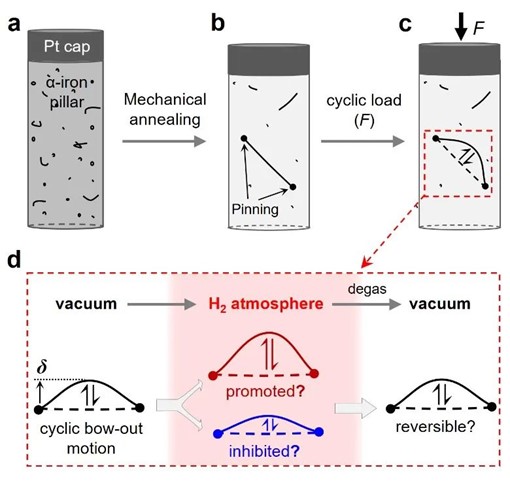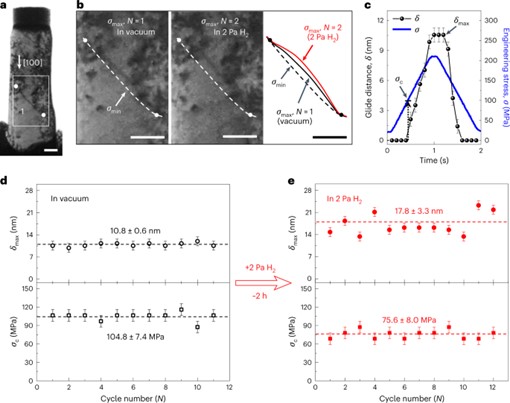Hydrogen is not only widely present in the energy and petrochemical industries as hydrogen gas and hydrogen sulfide, but also ubiquitous on the earth's surface in the form of liquid water and water vapor. Due to the extremely small atomic radius of hydrogen, it is easy to enter the interior of the material, resulting in reduced plasticity and delayed cracking, referred to as hydrogen embrittlement (HE), causing sudden and often catastrophic safety accidents. Therefore, the HE is a common safety concern in transportation, energy, petrochemical and other industries. Steel is the most widely used and also the most significant metallic structural materials, suffering the most severe HE problem.
Exact understanding of the intrinsic HE mechanism is essential for establishing HE prediction models and anti-HE design. Although multiple hydrogen embrittlement mechanisms have been proposed, a consensus has yet to be reached on the effects of these embrittlement modes, owing to the often intricate interplay of those mechanisms. Consequently, some reported macroscopic observations are contradictory. The most critical issue behind the formidable complexity is the exact interaction between hydrogen and the plastic carrier——dislocation (screw dislocation plays a leading role in plastic deformation of steels). However, direct, quantitative experimental proof of the influence of hydrogen at the single dislocation level is missing.
For this purpose, researchers from School of MSE of Xi'an Jiaotong University (XJTU) designed a fully quantitative in situ ETEM mechanical testing protocol, as illustrated in Fig. 1, that enables the observation and comparison of bow-out motion of the same dislocation segments under a vacuum and in a hydrogen-containing environment. The experimental results (Fig. 2 and 3) unambiguously prove that hydrogen promotes the movement of dislocations in pure iron. It is also found that cyclic loading/unloading can promote the degass of hydrogen from the hydrogen traps, e.g. dislocations, allowing the dislocation to regain its hydrogen-free behavior (Fig. 3). These findings at the individual dislocation level can inform HE modelling and guide the design of hydrogen-resistant steels.
These results were published in the latest issue of Nature Materials entittled 'Quantitative tests revealing hydrogen-enhanced dislocation motion in α-iron'.
Link: https://www.nature.com/articles/s41563-023-01537-w

Fig. 1 Schematic of the experimental set-up for revealing the effect of hydrogen on dislocation motion

Fig. 2 Effect of hydrogenation on the bow-out motion of a screw dislocation

Fig. 3 Effect of hydrogen degassing on dislocation behaviours
Prof. Degang Xie and Prof. Zhiwei Shan from XJTU are the co-coresponding authors of this paper. Dr. Longchao Huang from XJTU and Prof. Dengke Chen from Shanghai Jiaotong University are the co-first authors. Prof. En Ma and Prof. Suzhi Li from Xi 'an Jiaotong University, Prof. Ju Li and Dr. Yin Zhang from MIT, Prof. Ting Zhu of Georgia Tech. and Prof. Dierk Raabe from MPIE of Germany are also contributor authors in this work. This work was supported by the NSFC, Shaanxi Postdoctoral Science Foundation and Shanghai Pujiang Program.
Recommended articles on the study of HE and hydrogen damage mechanisms from the XJTU team (led by Prof. Shan and Prof. Xie) are as follow:
[1] D.G. Xie, Z.J. Wang, J. Sun, J. Li, E. Ma, Z.W. Shan, Nat. Mater. 14(9) (2015) 899-903;
https://doi.org/10.1038/nmat4336
[2] D.G. Xie, S.Z. Li, M. Li, Z.J. Wang, P. Gumbsch, J. Sun, E. Ma, J. Li, Z.W. Shan, Nat. Commun. 7 (2016) 13341;
https://doi.org/10.1038/ncomms13341
[3] M. Li, D.G. Xie, E. Ma, J. Li, X.X. Zhang, Z.W. Shan, Nat. Commun. 8 (2017) 14564;
https://doi.org/10.1038/ncomms14564
[4] D.G. Xie, L. Wan, Z.W. Shan, Corrosion Sci. 183 (2021) 109307.
https://doi.org/10.1016/j.corsci.2021.109307


